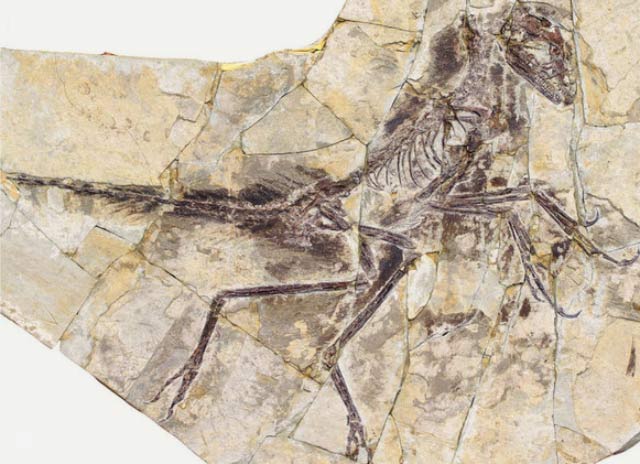I’m currently making my way through the December 2010
Evolution: Education & Outreach, a special issue dealing with the teaching of phylogenetics. On page 507 in an article titled “How to Read a Phylogenetic Tree,” by Deborah A. McLennan, I came across the following. “…butterflies can be distinguished from cats and people because they have an exoskeleton made out of chitin (a tough, waterproof derivative of glucose).” This was one of those “how do they know that” moments for me. Having read Genetics for Dummies and other books in my efforts to start getting a handle on genetics, I’m really getting into how genetic relationships reveal evolutionary history. Could this be another one of those cases?
But first I wanted to at least know what chitin is. Wikipedia says it “is the main component of the cell walls of fungi, the exoskeletons of arthropods such as crustaceans.” Interesting enough. It also says in terms of function it’s comparable to the protein keratin, and that it has several useful medical and industrial applications. Neat-o! But what about evolution? Does evolution have anything to say about where this stuff came from?
Plugging “evolution of chitin” in Google returns a bunch of links, and the very
first one I clicked on said, “[a]nalysis of a group of invertebrate proteins, including chitinases and peritrophic matrix proteins, reveals the presence of chitin-binding domains that share significant amino acid sequence similarity. The data suggest that these domains evolved from a common ancestor which may be a protein containing a single chitin-binding domain.” So it looks like these researchers have a pretty good idea about chitin’s history, and where it came from.
But the abstract also says that “comparisons indicated that invertebrate and plant chitin binding domains do not share significant amino acid sequence similarity, suggesting that they are not coancestral…We propose that the invertebrate and the plant chitin-binding domains share similar mechanisms for folding and saccharide binding and that they evolved by convergent evolution.”
So this research concludes that chitin in invertebrates evolved from a common ancestor, but invertebrate and plant chitin evolved independently.
Want to know
more? how about a possible history of the stuff in humans traced all the way back “to the time of the bilaterian expansion (approx. 550 mya).” Furthermore, this paper documents some real twists and turns in chitin’s history: “The family expanded in the chitinous protostomes C. elegans and D. melanogaster, declined in early deuterostomes as chitin synthesis disappeared, and expanded again in late deuterostomes with a significant increase in gene number after the avian/mammalian split.” Someone has clearly done their homework!
This little exercise took me about 15 minutes, and I learned a little bit about chitin: what it is and got a glimpse into where it came from and how scientists are learning its history. Scientists doing science.
What do creationists say about chitin? I plugged the term in the search engine at
Answers in Genesis and found an article called “
What a Body!” by Professor Wolfgang Kuhn, who describes chitin as a “wonder substance” composed of protein and sugar. He further describes it as a “miracle body” and says that “even if we could produce chitin itself, all our modern technology would be unable to imitate this fine microstructure so as to make a sports car body out of it, for instance.”
What is the takeaway message of Kuhn’s article? “Next time you see this humble beetle, consider the incredible amount of programmed information needed just to construct this super-high-tech marvel, its outer coat. Such information is passed on generation after generation, silent testimony to the Master Programmer.”
Creationism is so easy! When the earth is only a few thousand years old, and plants, animals, everything on earth has no real history or past different from the present, it’s enough to call things “wonder substance” and “miracle body”. Poof! God did it… class dismissed.
I’ve often read creationists complain about the amounts of funding real scientists receive and how much is distributed by the NIH and the NSF. If only creationists had this kind of funding, they could do amazing research! But would they?
Answers in Genesis, perhaps the most visible and well-funded anti-evolution organization in the country, spent approximately $27 million building its creation “museum” in Kentucky. AiG is presently raising money for their latest venture, a Noah’s Ark theme park, estimated to cost $24.5 million when completed. I have a suggestion for Ken Ham and the folks at AiG. Why not spend a fraction of that 24 and a half million to actually do a scientific experiment? For instance: build a real ark, fill it with animals just like Noah is claimed to have done and float it out in the ocean for a year to test the hypothesis. Think of all the converts that would win when it worked! Hell, I’d get saved myself!
I emailed
Dr. John Hawks at the University of Wisconsin, Madison, and asked him about funding scientific research and he replied, “Last year NIH spent $8 million on the Cancer Genome Atlas, bringing it to a total of $43 million. This project works on the principle that cancer cells are engaged in an evolutionary process in the body that will often be convergent in different people, so that building a systematic atlas of the genes involved will help us understand and find effective strategies to treat different cancers.”
So for less than the cost of two huge, embarrassing testaments to ignorance and misinformation AiG could have funded something like the entire Cancer Genome Atlas. But then again, at the creation “museum” they have a
Triceratops with a saddle!
It’s clear that for a fraction of what the creationist organizations spend on propaganda, they could easily fund lab work and research to publish evidence of their claims. But what they do publish is nothing more than distortions of real research. PZ Myers exposes a typical example about, coincidentally,
chitin.
Even some lower-tier creationists pull down some pretty serious dough.
Eric Hovind, son of federal prison inmate and notorious huckster Kent Hovind, is raising $1.5 million to make a film about the book of Genesis. In the 2011 Winter issue of his publication Creation Today, Son of Hovind claims he’s raised over $255,000.
Well, Eric Hovind has a high tech studio he makes his videos in, and I bet he has a few computers around there. What more does he need? Reed Cartwright, Biodesign Institute at Arizona State University, tells me, “For a lot of computational genomics research, the data is already available and the only costs are for computers and salaries. And purchasing time on supercomputers is currently cheap.” So here’s another suggestion: Why doesn’t Hovind fund a couple of creationist geneticists to do some research when his computers are otherwise unoccupied? I’m sure he’d discover that every species on earth went through a genetic bottleneck about 4400 years ago that reduced the entire population to just two individuals … on a boat. Right, Eric?
Opportunities abound for creationists to fund real scientific research. Nick Matzke sent me
this link. Use the Award Search feature and spend a few minutes checking out all the great research done on much smaller budgets than a theme park, or feature length film production.
Maybe scientists and creationists have the same facts. But if they do, it’s because one of those groups actually cared enough about truth to find out what the facts were. It’s not the creationists. Only one of those groups selfishly obsesses over their personal beliefs to the point of ignoring and distorting legitimate scientific research to further a social and theological agenda. And it’s not the scientists.
Note: As has been pointed out to me, what I have discovered in these papers is research on the evolution of chitin-binding proteins, not chitin itself. This layperson has learned that chitin is made from and digested by proteins that do evolve, and that’s what the research I found was all about.
* I say ‘virtually’ because with the tens, or hundreds, of thousands of members across all those organizations there are probably a couple of young-earthers. But I’ll bet you can’t find one geologist, anywhere, who thinks the earth is six thousand years old who doesn’t regard the Bible (or whatever their favorite holy text is) as without error.
(Finally, this piece is cross-posted to my brand new blog,
sciencedenial.com, so come on over to my place and give me some of your Internet love, you bunch of bad low motor scooters.)





